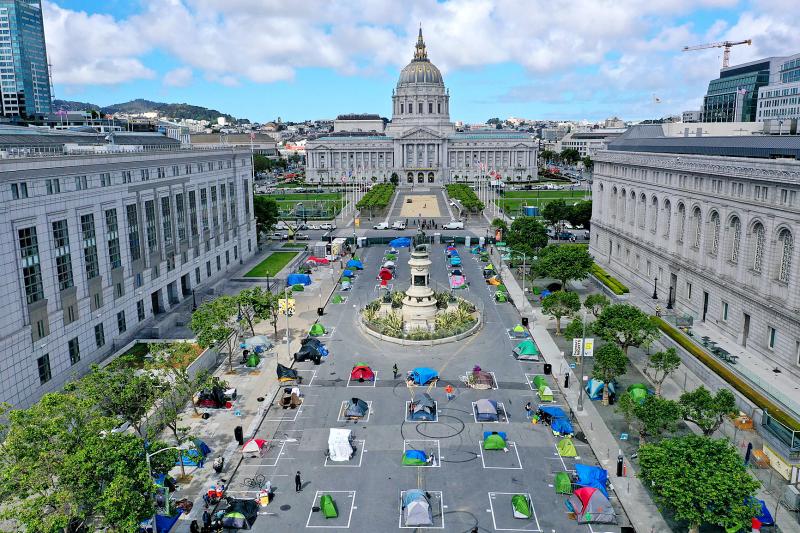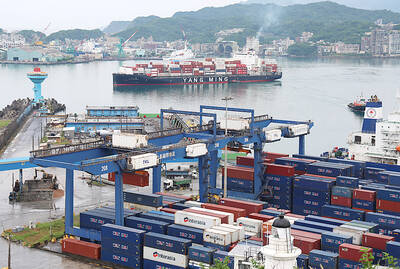Uber Technologies Inc, Lyft Inc and Airbnb Inc have slashed thousands of jobs. Salesforce.com Inc and Visa Inc are letting employees work remotely for months; Twitter Inc and Square Inc are allowing them to do so for good.
For the companies’ hometown of San Francisco, the moves are early signs of a dire blow.
In a city with a long history of booms, busts and natural calamities, the COVID-19 pandemic has suddenly upended nearly a decade of prosperity. While municipalities across the US are grappling with economic fallout from the virus, San Francisco stands to take a deeper hit given its high concentration of office jobs that make remote working easier, a tech industry battered by layoffs and a pricey real-estate market that has already driven out some residents.

Photo: AFP
The city’s leaders predict a US$3.6 billion budget shortfall over the next four years, with the unemployment rate — as low as 2.2 percent a few months ago — to be at about 15 percent through September.
If business taxes, the second-biggest source of revenue, continue to decline and the property tax base erodes, “all city services would suffer,” city Controller Ben Rosenfield said in an interview.
It is a marked turn from the years of growth that made San Francisco a symbol of massive wealth — while also fueling gaping inequality and a homelessness crisis that has led to people sleeping on streets alongside swank office towers.
The pain wreaked by the pandemic is only accelerating negative trends for the city, such as the departure of companies, conventions and residents to less-expensive areas, Berkeley Haas Fisher Center for Real Estate and Urban Economics chairman Ken Rosen said.
“The boom is over and the question is how deep will the bust be,” said Rosen, who warned that the city might have diminished appeal to the tech industry. “We are going to need dramatic changes if we’re going to keep our golden goose here.”
Rosen expected San Francisco’s recovery to lag that of other US cities, which combined might lose about US$360 billion of revenue through 2022 because of the pandemic, a National League of Cities analysis showed.
As a whole, more densely populated, expensive locales might find themselves hit harder than others. Why live in a metropolis heralded for its bars and restaurants if you cannot safely patronize them or take mass transit without fear?
“The appeal of living in such large cities is definitely going to deteriorate in the next year or two, if not up to five years,” Moody’s Analytics economist Laura Ratz said. “If it takes two, three years to get a vaccine, these large cities like San Francisco are going to suffer for it.”
Major companies around the world are retooling office space for fewer workers, scouting suburban sites and considering permanent telecommuting.
In the Bay Area, there might be a particularly profound effect: About 40 percent of jobs depend on traditional office-using industries, double that of the US, according to Moody’s Analytics.
Most large firms in and around San Francisco are preparing at least partial remote-work policies, according to a survey this month from the Bay Area Council, a business organization.
About one-third of newly remote workers surveyed by brokerage Redfin Corp expected to remain so even when restrictions ease and more than half would consider moving away from San Francisco if they never had to show up to jobs in person.
Facebook Inc, based in Silicon Valley, has said that half of its workforce might be remote in 10 years.
In the meantime, San Francisco is dealing with the immediate hit to its revenue. The city and surrounding counties were the first in the mainland US on March 16 to order residents to stay at home to slow the spread of the virus — a move that has been credited in helping the region fare better than others in managing the outbreak, while also lengthening the blow to the economy.
The city’s payroll tax is calculated on work performed within its borders, and telecommuting is leading to an overall 8 percent drop in business taxes this year from the previous one. They were originally estimated to rise 15 percent. The tourism and convention industry has cratered, and hotel taxes next year are expected to drop by almost 60 percent from last year.
San Francisco Mayor London Breed is to release an interim budget tomorrow reflecting the turnabout in the city’s fortunes. She has already told departments to cut costs by 10 percent for the next fiscal year and to decide which municipal jobs can become permanent work-from-home positions.
The city is to adopt its final budget by October.
Still, San Francisco has suffered economic collapses before only to emerge stronger, and corporate policies are in flux. Remote work can help companies ride out the pandemic, which might ultimately help the city’s economy. If larger firms give up some real estate, that presents an opportunity to smaller businesses and nonprofits struggling to get space, former city supervisor and California Senator Scott Wiener said.
Another possibility: Companies might end up taking additional office space if they need to implement spatial distancing and other practices to reduce the virus risk, city Assessor Carmen Chu said.
She is one of the chairs of a city economic recovery task force that is not only addressing the immediate crisis, but sketching out ideas for how businesses can succeed.
“We have a city full of problem solvers,” said Rodney Fong, cochair of the task force and president and chief executive officer of the San Francisco Chamber of Commerce. “Creativity and innovation will bring San Francisco back to maybe an even more dynamic place than it was, over time.”

CHIP RACE: Three years of overbroad export controls drove foreign competitors to pursue their own AI chips, and ‘cost US taxpayers billions of dollars,’ Nvidia said China has figured out the US strategy for allowing it to buy Nvidia Corp’s H200s and is rejecting the artificial intelligence (AI) chip in favor of domestically developed semiconductors, White House AI adviser David Sacks said, citing news reports. US President Donald Trump on Monday said that he would allow shipments of Nvidia’s H200 chips to China, part of an administration effort backed by Sacks to challenge Chinese tech champions such as Huawei Technologies Co (華為) by bringing US competition to their home market. On Friday, Sacks signaled that he was uncertain about whether that approach would work. “They’re rejecting our chips,” Sacks

Taiwan’s exports soared 56 percent year-on-year to an all-time high of US$64.05 billion last month, propelled by surging global demand for artificial intelligence (AI), high-performance computing and cloud service infrastructure, the Ministry of Finance said yesterday. Department of Statistics Director-General Beatrice Tsai (蔡美娜) called the figure an unexpected upside surprise, citing a wave of technology orders from overseas customers alongside the usual year-end shopping season for technology products. Growth is likely to remain strong this month, she said, projecting a 40 percent to 45 percent expansion on an annual basis. The outperformance could prompt the Directorate-General of Budget, Accounting and

NATIONAL SECURITY: Intel’s testing of ACM tools despite US government control ‘highlights egregious gaps in US technology protection policies,’ a former official said Chipmaker Intel Corp has tested chipmaking tools this year from a toolmaker with deep roots in China and two overseas units that were targeted by US sanctions, according to two sources with direct knowledge of the matter. Intel, which fended off calls for its CEO’s resignation from US President Donald Trump in August over his alleged ties to China, got the tools from ACM Research Inc, a Fremont, California-based producer of chipmaking equipment. Two of ACM’s units, based in Shanghai and South Korea, were among a number of firms barred last year from receiving US technology over claims they have

BARRIERS: Gudeng’s chairman said it was unlikely that the US could replicate Taiwan’s science parks in Arizona, given its strict immigration policies and cultural differences Gudeng Precision Industrial Co (家登), which supplies wafer pods to the world’s major semiconductor firms, yesterday said it is in no rush to set up production in the US due to high costs. The company supplies its customers through a warehouse in Arizona jointly operated by TSS Holdings Ltd (德鑫控股), a joint holding of Gudeng and 17 Taiwanese firms in the semiconductor supply chain, including specialty plastic compounds producer Nytex Composites Co (耐特) and automated material handling system supplier Symtek Automation Asia Co (迅得). While the company has long been exploring the feasibility of setting up production in the US to address